The Samsung Galaxy S6 and S6 edge Review
by Joshua Ho on April 17, 2015 9:00 AM EST- Posted in
- Smartphones
- Samsung
- Mobile
- Galaxy S6
- Galaxy S6 Edge
System Performance
In order to test the Exynos 7420 and the phone in general, we turn to our suite of benchmarks which are able to show how the device performs in common general computing workloads. Something as simple as web browsing is still surprisingly intensive on mobile phones, and in general Android can often be quite stressful to run in the constraints of a ~3W total TDP especially on any phone still running Dalvik due to its strong reliance on bytecode and a virtual machine that translates bytecode to machine code just before and during application runtime. ART improves this significantly, but is limited in the nature of optimization as AOT compilation optimizations are limited by the CPU power of the SoC and the need to compile the application in a reasonable amount of time.
As always, we'll start things off with our browser benchmarks. After getting to use the phone, it became clear to me that Chrome is poorly optimized against the Galaxy S6 as Samsung’s browser is clearly superior in performance. For that reason I've gone ahead and run our benchmarks on both Chrome and on the stock browser, as seen below.

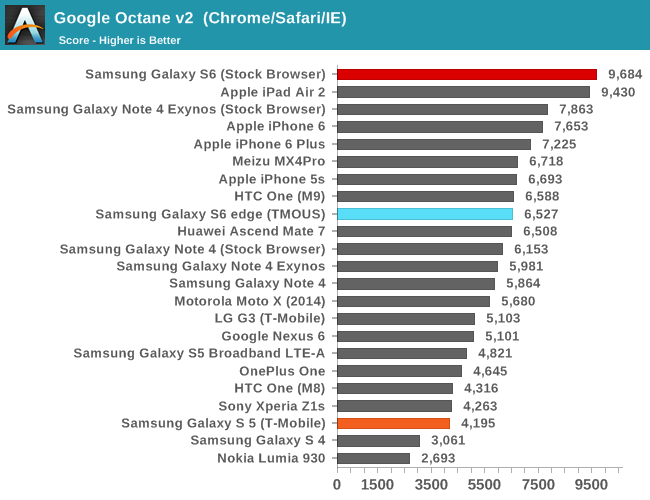

Needless to say, in order to see the full potential of the Exynos 7420 and its cluster of A57s, it’s necessary to use Samsung’s stock browser. This performance is really quite amazing when compared to Apple’s A8X, which has basically been the gold standard for performance in the mobile space in the context of ARM SoCs.
Moving on, as a part of our updates to the benchmark suite for 2015, we'll take a look at Basemark OS II 2.0, which should give a better picture of CPU performance in addition to overall device performance.
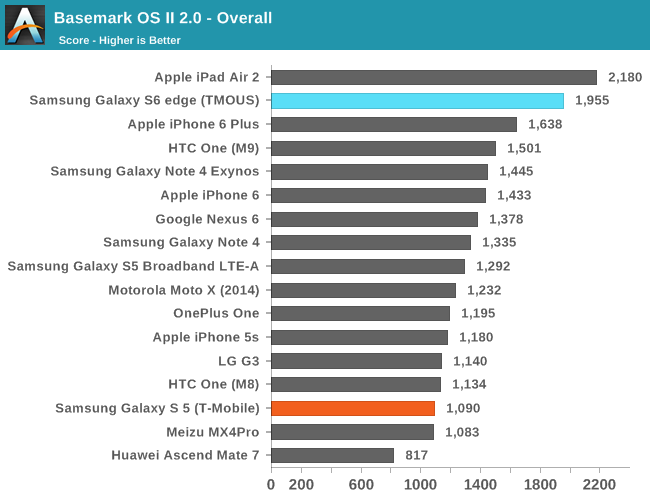
The browser benchmarks seem to hide some pretty enormous variability as the Galaxy S 6 edge (which is comparable to the Galaxy S 6) sets a new record among Android devices. The only challenger is the iPad Air 2, which uses the A8X SoC with three Enhanced Cyclone cores and the semi-custom GXA6850 GPU.
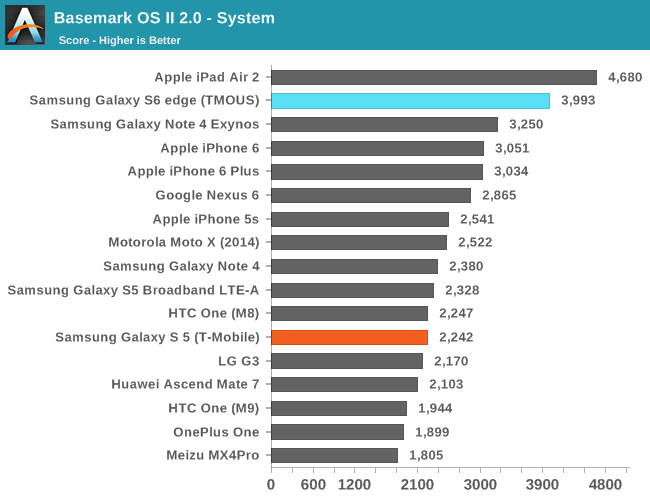
This system test contains a floating point and integer test, in addition XML parsing, which means that this test mostly stresses CPU and RAM. Interestingly enough, the Exynos 7420 pulls far ahead of both the Exynos 5433 and Snapdragon 810 in this test, and approaches the A8X. The difference between the 5433 and 7420 is likely a combination of the higher clocks on both the A57 and A53 clusters for the 7420 (1.9/1.3 on the 5433, 2.1/1.5 on the 7420), in addition to the ability to stay at a high 'overdrive' clock due to reduced leakage from the 14LPE process. The One M9 likely falls a bit short here due to HTC's governor settings restricting the use of all 8 cores simultaneously.

While one might guess that the memory test of 'Basemark OS II 2.0 - Memory' is of RAM, this is actually a test of the internal storage. Once again we see the S6 edge come close to leading the pack due to the use of the new UFS (Universal Flash Storage) standard. Casual examination reveals that the S6 edge has a queue depth of 16, and that it identifies itself with the rather cryptic model name of KLUBG4G1BD-E0B1.
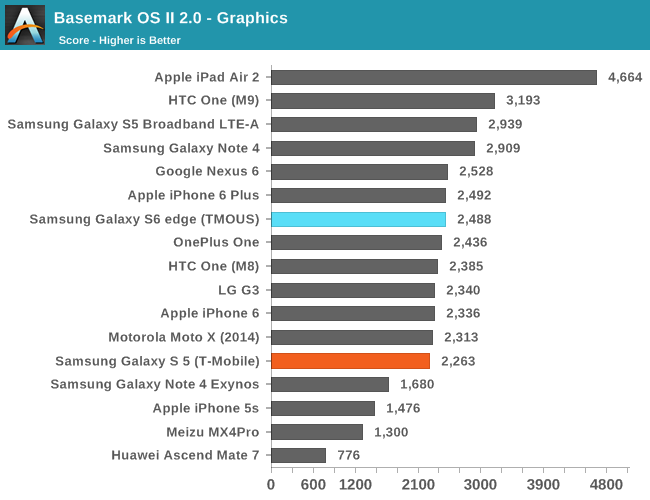
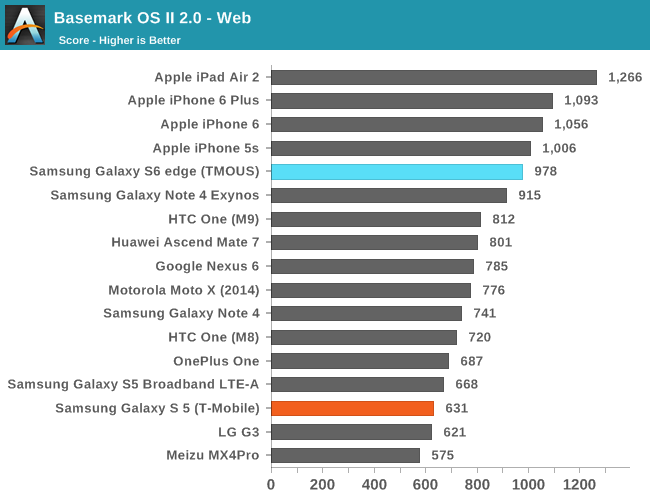
For the web test, it uses the built-in WebView rendering engine rather than Chrome and paints a distinctly different picture, especially because these tests are focused on HTML5 and CSS rather than JavaScript. Here we can see that the iPhone 6 and iPad Air 2 continue to hold their lead, but the Galaxy S6 is pretty much the king of the hill when it comes to Android devices.
Our next system benchmark is PCMark, which does a number of basic benchmarks designed to stress various aspects of the device in everyday workloads like video playback, web browsing, text editing, and photo editing. This tends to test every aspect of a mobile device, unlike microbenchmarks that can often miss aspects of the system that can affect performance.
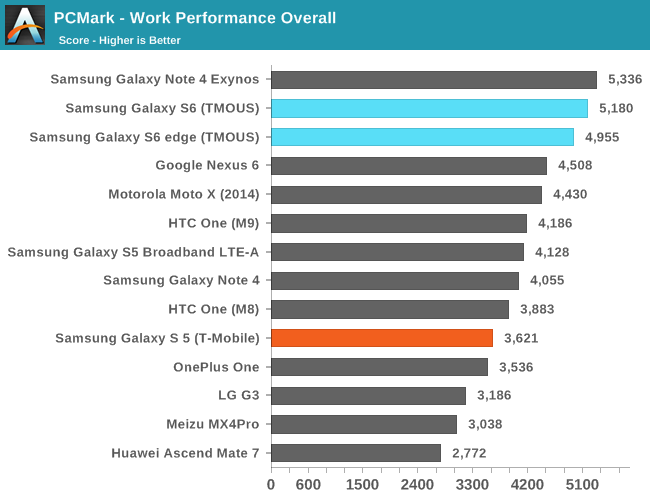
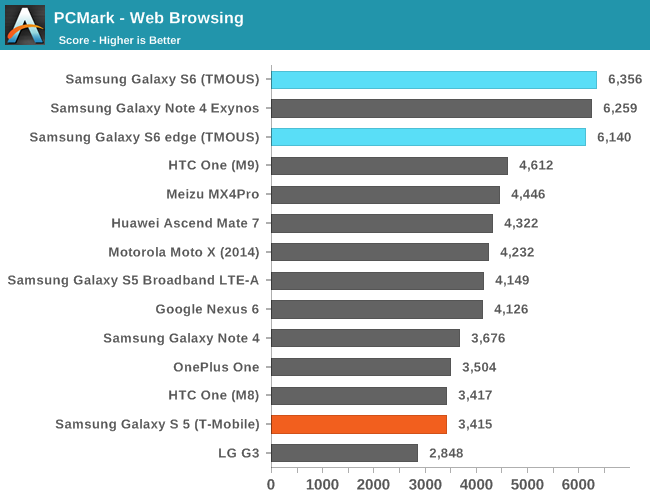
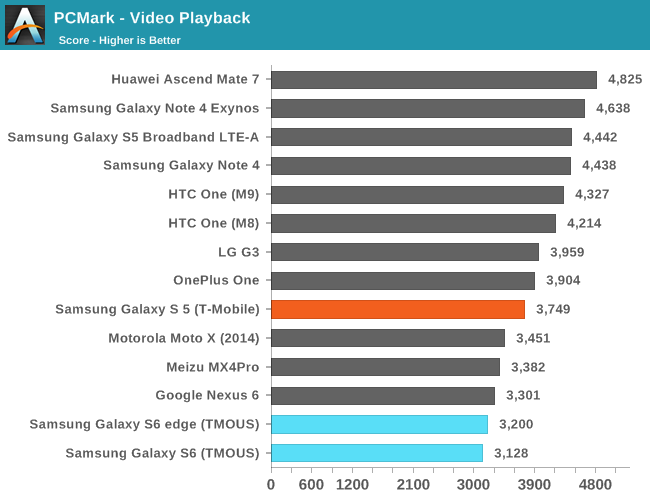
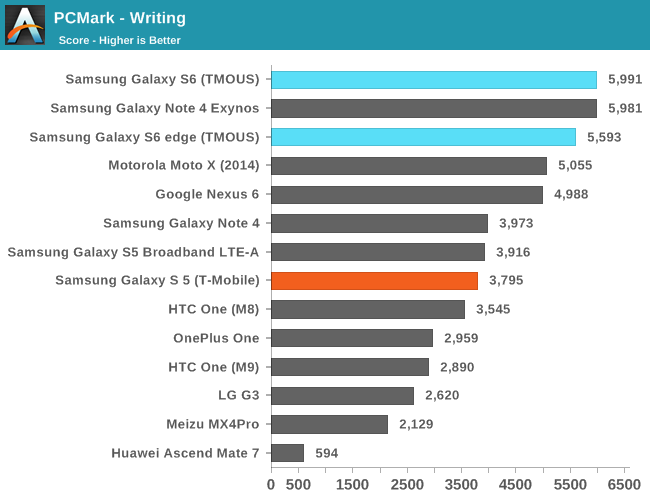

In these tests, the Galaxy S6 continues to perform strongly here due to the fast NAND storage solution and the Exynos 7420 SoC. As we have already covered the Basemark OS II 2.0 results in previous articles, I would refer back to it as those scores are final and have already been contextualized.
Overall, in these general purpose computing tasks that stress CPU, memory, and NAND performance we can see that the Exynos 7420 is off to a flying start. Samsung Mobile should focus more strongly on optimizing the software stack against Chrome as mobile Chrome has around twice the user share of stock Android browsers. I often say that the SoC is the foundation to a good smartphone, and in the case of the Galaxy S6 it feels like this is especially true.










306 Comments
View All Comments
Calista - Friday, April 17, 2015 - link
It's funny, two years ago I predicted this very phone. But I did not assumed it would be a replacement for the S-series, rather a new tier. But maybe as other have said the Note series will be the new "everything and the kitchen sink", with S now standing for stylish. And the edge looks amazing, the first major step in cellphone design in the last five years.Lundkeman - Friday, April 17, 2015 - link
How about enabling Full Disk Encryption (FDE), then perform all tests again, then re-post the results.Thanks
johnnohj - Friday, April 17, 2015 - link
http://forum.xda-developers.com/galaxy-s6/general/...According to the benchmarks in this post on XDA, there seems to be no noticeable impact on S6 performance after encryption, except for random write which is ~17% slower.
I hope Samsung enables it by default on future devices.
Lundkeman - Friday, April 17, 2015 - link
Thats great for the xda site, but I would like to see results side by side for the tests that anandtech posted.arayoflight - Friday, April 17, 2015 - link
The device is ARMv8 based. Hence, it has hardware encryption built in and won't affect the performance even if you enable FDE.Lundkeman - Friday, April 17, 2015 - link
In theory, I would still like to see where, if any, there are hits. I think battery life may be one.gigathlete - Friday, April 17, 2015 - link
I am also interested in seeing the same tests with FDE on.LordConrad - Friday, April 17, 2015 - link
I am against fingerprint sensors in phones as it gives people a false sense of security. Fingerprints, like DNA, can be subpoenaed. If you have sensitive data on your phone (legal or otherwise), a fingerprint lock is not sufficient. You need to use a password or pattern lock, which cannot be subpoenaed.Margalus - Friday, April 17, 2015 - link
what kind of "legal" activity are you worried about being subpoenaed? If you are using this for illegal activities who cares if you get subpoenaed?Drumsticks - Friday, April 17, 2015 - link
Just because you have nothing to hide doesn't mean you let the cop search your home without a warrant. It's just about general security.